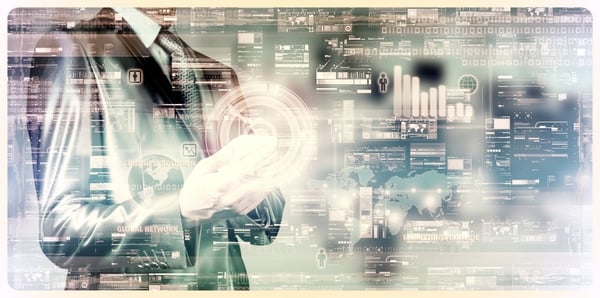If paperless events were an exciting step forward for your company in 2016, you may be blown away by the technology trends that promise to alter the landscape of events in 2017. In the span of just a few short years, we’ve moved from paperless being an exciting step forward to the likely adoption of technologies like virtual reality and artificial intelligence to amplify the event experience.
The companies who will have the most success are those that are planning now for how they’ll use these trends and technologies to their advantage in 2017. As you begin planning your strategic business initiatives for the next year, consider how you might utilize the following five major technology trends to enhance your event landscape in the coming year to amplify both the consumer experience and your event intelligence.
1. Beaconing
Retail stores have been taking advantage of beacon technology for a couple years now, but it’s only recently that beacons have started to gain traction as fixed features at events. Beacons are sensors (the size of a golf ball) that can be strategically placed in important areas to drive traffic and engage with event attendees through targeted messaging and promos.
When paired with a mobile event app, beacons can send an alert to participants’ mobile phones when they’re near an important area within your event venue. This helps keep attendees alert and engaged.
Another benefit of pairing beacon technology with a mobile event app is it feeds into big data initiatives. Both the beacons and the app collect critical—and contextual—event data from a venue and user perspective. This helps with collecting and analyzing event data to measure event success and plan for your next initiatives regarding how/where participants spend their time and what/when they interact with it.
Visitor tracking analytics provide a wealth of data that can be used to pursue future sales and improve future events—you can track which presentations and areas drew the most interest, which saw little traffic, and which drew the most attention from your most important prospects and clients. This information can be incredibly useful for your sales team when driving toward future conversions, and to your event planning team when establishing agendas for future events.
2. Live Streaming
Live event streaming is a virtual front-row seat. For attendees that can’t make it or those that aren’t on-site, attendees can watch highly anticipated presentations broadcast through a mobile app, your event platform, and across social channels like YouTube, Twitter, and Facebook. If your event profits are driven by ticket sales, you probably don’t want to live stream everything that happens at your event, but live streaming important presentations and shots of people networking in community areas can be an excellent way to drive excitement for future events.
Allowing the public to get an inside view of your event increases your target audience’s desire to attend future events and generates social buzz for your company, brand, and events. Additionally, some social media experts believe that the future of social media will be all video content:
-
One of Facebook’s VPs predicted in June that within five years, Facebook “will probably all be video.”
-
Live streams on Facebook are more likely to appear in user’s news feeds than other types of content.
-
93% of internet users watch videos online.
Live streaming is an excellent event marketing technique that we’re certain to see more and more companies adopt as part of their event business model in 2017.
3. Virtual Reality
While virtual reality (VR) may sound like a toy, the technology has the potential to completely redefine how business is conducted. Facebook is already working on technology that will allow a group of friends to hang out virtually using VR technology, and that same technology will be able to be used for events and meetings to create a more personal experience for remote attendees.
Virtual reality technology will allow remote attendees to enjoy the complete event experience. Rather than simply watching a video, they can sit in their chair and view other participants sitting next to them, watch as they raise their hands to ask questions, and hear their questions. In meetings, virtual reality can be used for all participants to sit at a table together and interact without the view-switching and delays of video chats between multiple remote participants.
V
irtual reality technology may be in its infancy at the moment, but expect it to become a feature of events in 2017 as advances in the technology allow for creative uses of it in a business environment. Facebook has so much faith in the technology that they acquired Oculus—a leading VR company—for $2 billion in 2014. Additionally, even though the technology is relatively new, 40% of internet users are interested in using it.

4. Event Intelligence
In the past, gathering data from an event was a manual, arduous process, and often determining the ROI from an event was guesswork at best. However, with advances in big data and tracking, that is no longer the case. Using a mobile app as an event concierge enables an improved customer experience, and it also allows organizers to collect a wealth of important and useful data:
-
Determine how many people attended your event
-
Measure attendance at presentations and visits to important areas against each other to determine which were most successful and which weren’t well-received
-
Collect data on which presentations/areas were of greatest interesting to your most promising prospects for use by your sales team to personalize pitches
-
Identify what topics generated the most buzz on social media before, during, and after your event
-
Pair event data with future sales figures to create a full picture of the ROI of an event
Today’s consumers demand a more personalized approach, and utilizing the big data provided through event intelligence is the easiest way to determine what personalization looks like for your most important prospects and customers. Expect wider adoption in event analytics usage in 2017 as well as continued technological advances in the gathering, consolidating, and reporting of big data for providing important event insights.
5. Artificial Intelligence
In October, the San Jose International Airport in California unveiled three robot assistants as part of their customer service team. The robots can provide travelers with directions to key areas around the airport, answer questions, and provide entertainment by playing music, taking selfies, and encouraging travelers to dance and sing.
The same technology can be adopted for events as a means of providing concierge service to visitors. AI robots can greet event visitors when they arrive, provide directions to key areas, and when paired with a mobile app, could possibly even offer recommendations based on what presentations event participants have already visited or viewed.
Beyond their usefulness, robots are also a lot of fun and are sure to impress and delight event-goers in 2017, especially those who encounter the AI for the first time at your event.
Preparing for the Future
This year brought a rise in paperless events, higher adoption of technology like mobile apps to aid in event organization and dissemination of event materials, and the push toward creating events that weren’t just a series of presentations—they were complete experiences. In many ways, technological advances drove these trends. For example, pairing an event app with social media integration allows brands to create an omni-channel experience for participants.
In 2017, we can expect technological advances to continue to drive successful events that enable higher profits while also providing an excellent consumer experience. All of these integrated touchpoints will help you craft a top-bottom event strategy that aids and enhances the pre, during, and post-event customer experience journey. Take time as we close out this year to imagine how you might adopt these new technologies to become an event trend-setter in 2017 and beyond...


